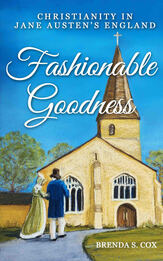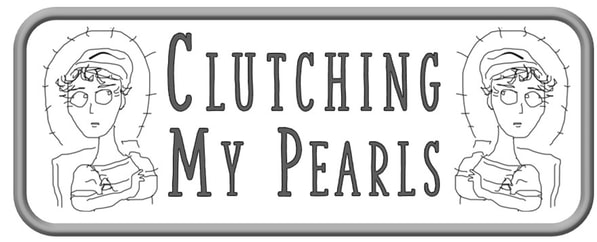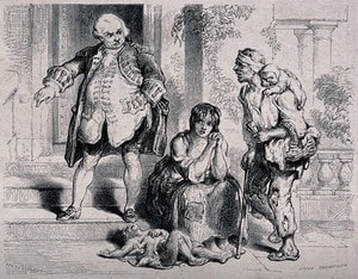| This blog explores social attitudes in Jane Austen's time, discusses her novels, reviews forgotten 18th century novels, and throws some occasional shade at the modern academy. The introductory post is here. |
Book Review

Cox has thoughtfully, even ingeniously, designed her book for maximum clarity and ease of reference. It begins with a basic overview of the nuts and bolts, shall we say, of the Church of England in Austen's time. Don't know a rector from a vicar? Don't know what a curate does? What's an "advowson"? Cox explains these and other church-related terms in engaging and clear prose. (She also provides a handy glossary).
Cox explains things that Austen's contemporary readers would have known all about: how a clergyman might get a "living," the role he played in society, and the basics of the Anglican church service.
Cox moves on to discuss the influence of the church more broadly, with frequent references to how Austen's Christian faith is reflected in her novels and in her private letters...
| The title, "Fashionable Goodness," alludes to churchgoers who—as Mansfield Park's Mary Crawford slyly suggested—go to church: "starched up into seeming piety, but with heads full of something very different." In Austen's lifetime, the United Kingdom saw a rise of evangelicalism, a movement to replace lip-service to religion with active, devout, faith. Fashionable Goodness gives a valuable overview of the various "dissenting" or non-conformist factions and how their beliefs differed from mainstream Anglicanism. Scholars have long debated about how Austen herself felt about the evangelicals, because she both criticizes and praises them in her few surviving letters. Cox puts Austen's remarks into their social and historical context. Religious belief touched on everyday life, of course, including debates around charity and social class. Cox's chapters on the social ills of the Regency are mostly told through the biographies of notable people such as Hannah More, Elizabeth Fry and William Wilberforce, who educated the poor, reformed the prison system, and fought to end the slave trade. Cox shows that, again and again, it was ardent Christians who were the driving force behind these and other fundamental reforms. For example, Thomas Gisborne, author of Enquiry into the Duties of the Female Sex, doesn't get much love today, but he "promoted laws limiting days and hours of factory work for workers' spiritual good and physical health." | Jane Austen attended Chawton Church while she was writing or rewriting her novels. Her brother Henry, who became an Evangelical clergyman, served as curate here in 1816, earning 52 guineas a year.Photo © Brenda S. Cox, 2022 |
| "The poor man at his gate:" The father is on crutches, probably because of a work injury. Therefore this family qualifies as "the deserving poor" who should be helped. Christians appealed to the privileged to help the poor. | Austen is also referring, sardonically or not, to the wide-held belief that God ordained everyone's station in life. As the 1848 hymn, All Things Bright and Beautiful, affirmed: The rich man in his castle The poor man at his gate God made them, high or lowly And ordered their estate. Cox acknowledges that our modern values do not always align with the Regency worldview. The purpose of this book is not to excuse the past—and certainly Cox doesn't hold up the past merely to criticize it. This book explains the past and shows how some of the reform movements begun in the Regency era are still active in the world today. Cox covers all this and more in a concise, information-packed, and readable style, drawing on scholarly as well as contemporary sources. She brings it all alive with the everyday voices of people from the Regency era. |
Finally, we learn how the moral crusaders of the Regency led into the Victorian era, and how women, inspired by their faith and the desire to help their fellow men, joined together to work at the forefront of social reform.
Fashionable Goodness provides a key to understanding Austen's world--you will see how her values are reflected in her characters and her plots. If you read and re-read Austen, this book will enhance your enjoyment and understanding. If you're a devoted Austenite, you'll love this book, and if you aspire to write Austen-inspired fiction that is true to its source material, Fashionable Goodness is an invaluable source.
Fashionable Goodness: Christianity in Jane Austen’s England is now available from Amazon and Jane Austen Books.

Brenda S. Cox has loved Jane Austen since she came across a copy of Emma as a young adult; she went out and bought a whole set of the novels as soon as she finished it! She has spent years researching the church in Austen’s England, visiting English churches and reading hundreds of books and articles, including many written by Austen’s contemporaries. She is a popular speaker at Jane Austen Society of North America (JASNA) meetings (including three AGMs) and her articles have been published in Persuasions On-Line (the JASNA journal). She contributes to the blog Jane Austen’s World and her own blog is Faith, Science, Joy, and Jane Austen. Now that her book is finished and launched, Brenda says: "I hope to go back to writing the novel I originally set out to write, but we shall see what happens! Writing is my fourth career, after chemical engineering, homeschooling my children, and training people in learning languages."
| Other authors Inspired by Brenda's book, I've added a new category— "Religion in Austen" —which will take you to posts which touch on the subject in this blog. There were many authors who were more didactic and openly preachy than Austen. I discuss some of them in previous posts, such as the Rev. James Thomson, Medora Gordon Byron, and of course Hannah More. Regardless of one's background, personal beliefs, or religious traditions, I think knowledge of the basics of the Anglican faith is useful (to say the least) for understanding Austen's novels and her world view. A future post will look at how Methodists were portrayed in the novels of the long 18th century. It was quite a surprise to me, since my Methodist ancestors were the all the soul of respectability! | I especially enjoyed Brenda's chapter on church music. Her explanation about fitting the lyrics to the meter made me understand why the Methodist hymns of my childhood go bone-deep in my memory. |



 RSS Feed
RSS Feed